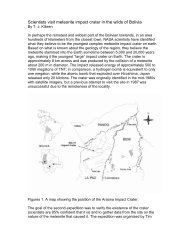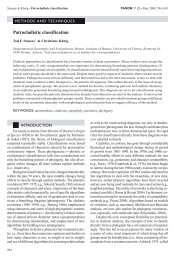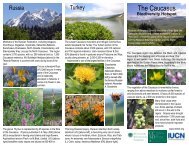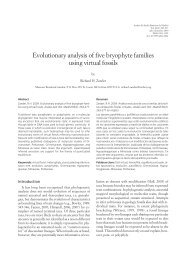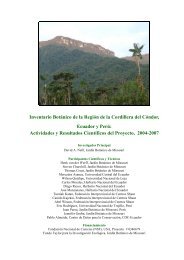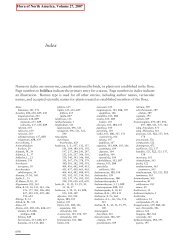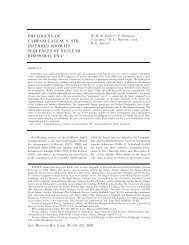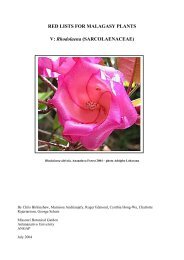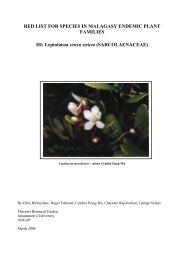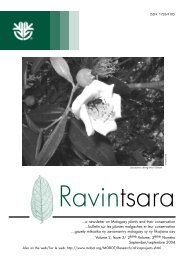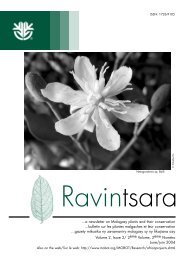red lists for malagasy plants iv: sphaerosepalaceae - Missouri ...
red lists for malagasy plants iv: sphaerosepalaceae - Missouri ...
red lists for malagasy plants iv: sphaerosepalaceae - Missouri ...
You also want an ePaper? Increase the reach of your titles
YUMPU automatically turns print PDFs into web optimized ePapers that Google loves.
Dialyceras discolor J. F. Leroy Risk of Extinction: Critically Endange<strong>red</strong> (A3c)<br />
Vernacular names: Lombiro, Tsimandrasala Conservation recommendations: inclusion of populations in<br />
new conservation sites<br />
Description:<br />
Large tree. Leaves medium, venation pinnate, secondary and<br />
tertiary veins barely evident, lower and upper surfaces<br />
colo<strong>red</strong> differently in dried material. Inflorescence terminal<br />
(axillary) with 1 - 3 flowers. Flowers large, with 4 sepals, 4<br />
petals that fall quickly, many stamens. Fruit consisting of 1-<br />
4 separate, large, fleshy, pear-shaped, curved fruitlets<br />
(mericarps); pedicel with golden hairs.<br />
Habitat:<br />
• Vegetation type: low elevation evergreen <strong>for</strong>est<br />
• Bioclimate: humid<br />
• Geology: basement rock, alluvial and lake deposits, lava<br />
• Altitude: 120 - 230 m<br />
Biology:<br />
• Pollination: probably insect (on basis of flower<br />
characteristics also observations of bees visiting the flowers<br />
of other Dialyceras species)<br />
• Seed dispersal: probably lemurs (on basis of fruit<br />
characteristics and observations of consumers of fruits of<br />
other Dialyceras species)<br />
Uses:<br />
None reported<br />
Distribution:<br />
Observations of study population(s)<br />
• Location: Ambodigavo (14°52’05’’S, 50°05’44’’E)<br />
• Regeneration observed: Yes<br />
• Tolerant to disturbance: No<br />
• Density: 10 mature ind<strong>iv</strong>idual per ha.<br />
• Abundance: 1,000 - 2,500 mature ind<strong>iv</strong>iduals<br />
P<strong>red</strong>icted future decline:<br />
• because of habitat loss: >80% (cause of loss = shifting<br />
cult<strong>iv</strong>ation)<br />
• because of exploitation or poor regeneration: unknown, but<br />
poor regeneration possible if animal seed dispersers become rare<br />
because of hunting.<br />
Distribution attributes <strong>for</strong> population<br />
• Extent of occurrence: 1,955 km²<br />
• Area of occupancy: 1,112 km²<br />
• Number of subpopulations: 4<br />
Representation in protected areas:<br />
• Number of subpopulations: 0<br />
• Protected areas: None<br />
Specimens examined: Antsiranana: Marohambihy, SF 7777 ; Antalaha, Barot s.n. ; Antsirabe-Nord, SF(R. Capuron) 27592 ; Ambodigavo, SF 13851 ;<br />
Ambodigavo, SF(R-305) 24-R-305 ; Ambatoasana, F. Randriantafika et al. 43.<br />
13





